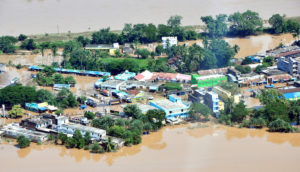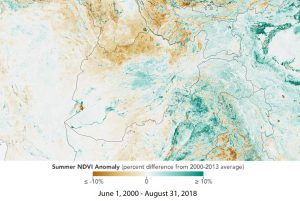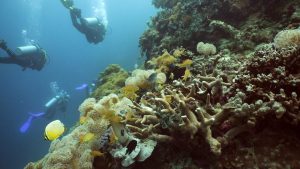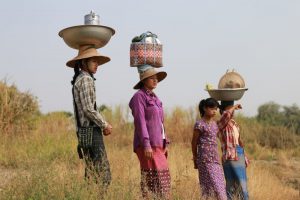Bhutan is in the final phase of choosing its third democratically elected government, with elections due on October 18. Since preserving the environment has been a critical part of the country’s unique development path, political parties cannot avoid the question on how they will handle this issue.
Bhutan has two rounds of elections, with the first round for multiple parties, and the second for the two parties that received the highest share of votes in the first round. This time Druk Phuensum Tshogpa (DPT) and Druk Nyamrup Tshogpa (DNT) are in the final round. The DPT had formed the first elected government of Bhutan in 2008. The DNT had not made it past the first round during the last poll, in 2013. The People’s Democratic Party (PDP), which had been the Opposition party after the first election, and had won the 2013 elections, came third in the first round, and is not in the running.
Both DPT and DNT have incorporated pledges such as forest conservation, water and waste management in their party manifestos. A closer, though, look reveals that many of these issues have not been clearly thought through by either party.
During the pre-poll debates, the founder of DNT, Tandin Dorji, pledged to focus on encouraging use of alternative sources of energy and to reduce dependence on fossil fuels. Bhutan imports BTN 8 billion (USD 109 million) worth of fossil fuels, which is equivalent to 67% of its earnings through hydropower – Bhutan’s largest revenue earner. Dorji pledged that, if elected, DNT cabinet ministers would use hybrid cars to set an example. He also pledged that the party would encourage the use of biogas and the use of electrically powered induction cookers.
![The main poster for the DNT [image courtesy: DNT Facebook page]](https://dialogue.earth/content/uploads/2018/10/DNT.jpg)
The big question mark over cars
However, the DNT’s pledge to reduce fossil fuel consumption is contradicted by its promise to provide “a vehicle quota for each family, and increased vehicle quota ceiling for civil servants.” The DPT has also promised to revise the vehicle quota. The current vehicle quota ceiling – which allows a person to be exempt from taxes and duties – is BTN 800,000. Given that import taxes can add up to 125% – 25% being a green tax – getting a quota is a large incentive to buy a vehicle.
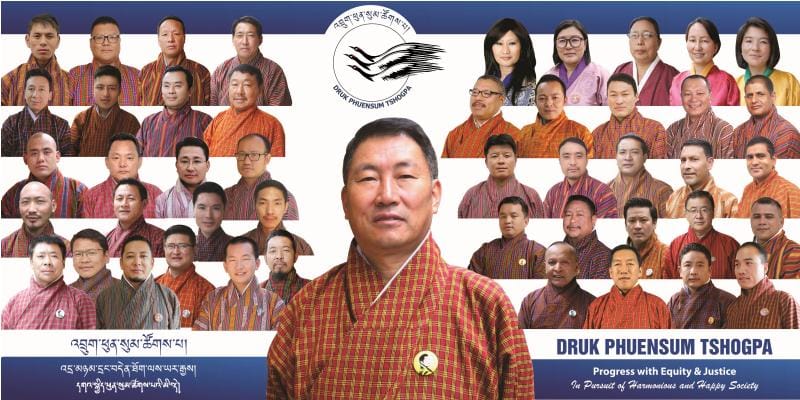
Vehicle quota for each family and revised quota ceiling for civil servants would mean encouraging people to buy more cars. Bhutan is already faced with increasing number of vehicles. Records with the Royal Safety and Transport Authority showed there are 97,900 vehicles in the country as of August 2018. In 2001 the number was only 22,527. In a country with an estimated population of only 800,000, Bhutan now has a car for every eighth person.
None of the two parties has a pledge to deal with this problem. Although cities in Bhutan are in desperate need of improved transport systems, during the ten years of democratic governments, only 185 buses were reported to have been added to the fleets. This, despite the call – in 2010 – of Tshering Tobgay, who was leader of the Opposition in the first government, and Prime Minister of Bhutan from 2013 to 2018, to upgrade public transport.
Where’s the wood?
There is a problem with DPT’s pledge to invest in, and promote, wood based industries. Last week, the Kuensel, Bhutan’s oldest and most widely read newspaper, reported that due to the increasing construction in Bhutan, records with the forestry department show a rising demand for timber over the years exerting more pressure on the state-owned forests.
Both the proliferation of cars and the building boom are tied to rising wealth in Bhutan. Bhutan had a subsistence economy less than two generations ago. Now it is well on its way to become the first Asian nation to graduate from the “Least Developed Country” category.
Read: Bhutan to graduate from being a Least Developed Country
This transition has been driven by a development policy that emphasised environmental preservation, with run-of-the-river hydropower projects being the main contributor to Bhutan’s wealth. This sensibility is reflected even in its tourism sector, which has been another high revenue earner for Bhutan, with a ban on climbing mountain peaks as a mark of respect to local culture, which places a great deal of reverence on environmental aspects.
The Shingkhar-Gorgan conundrum
Few projects highlight Bhutan’s current confusion on growth and environment as the proposed Shingkhar-Gorgan road. The road promises to connect some of Bhutan’s least developed areas, but it will also run through one of Bhutan’s most important wildlife sanctuaries. Both DNT and DPT have promised to complete the construction of the much delayed and controversial project.
The 56 kilometre road project started during the tenure of the first elected government, but only about 20 kilometres of it has been completed. The National Environment Commission has stated that the remaining 37.28 kilometre stretch falls in the core zone of Thrumsengla National Park, and thus environmental clearances cannot be approved.
Read: Bhutan’s Shingkhar-Gorgan highway: development versus environment?
The leaders of DNT have promised to minimise the environmental damages while constructing the road in the core zone. The party was more interested in emphasising the benefits of the project rather than explaining the details of how the damages would be minimised. One idea being suggested by DNT members was to construct a tunnel road, although whether this would be suitable in the brittle mountains of the region was not clear.
The DPT, on the other hand, merely stated that they would finish the project that their party had started in its first tenure.
The future of hydropower in Bhutan
Hydropower is the backbone of Bhutan’s economy, but the construction of hydropower projects – including delays and cost escalations – have left Bhutan with a large and increasing debt. Hydropower contributes close to 25% of Bhutan’s revenue, but it also accounts for more than half of Bhutan’s external debt, which at more than 112%, makes it the most indebted nation in Asia after Japan.
Both the parties pledged to complete pending hydropower projects. DNT pledged to reform and strengthen the manpower and institutional capacity in hydropower development to ensure domestic energy security and the export of surplus hydropower for revenue. Its manifesto stated, “The national climate change adaptation strategy will be further strengthened by fostering public private partnership for enhancing the sustainable water resource utilisation.”
DPT promised to revamp the national target of increasing the electricity generation capacity from the present 1,606 MW (5.5% of total potential) to a minimum of 10,000 MW by 2030. “Bhutan will take comfort in the tremendous goodwill of India to fulfil this,” the party’s manifesto stated. “We will distribute mega hydropower projects evenly for balanced regional development. Provide on grid electricity for all. Update the National Transmission Grid Master Plan.”
The manifesto added, that the party will, “Provide fair compensation to individuals and communities affected by power projects and strengthen watershed protection and management.”
While connecting the whole population to the grid will not be difficult – 99.97% of households in Bhutan are already connected – these pledges ignore major challenges of hydropower. Bhutan has pursued run-of-the-river projects without big dams to minimise environmental damage, but even the dams built for these projects divert water through cemented channels, impacting the river basins as well as the flora and fish that inhabit the waters. Furthermore, as climate change impacts water flows in the region the economics of hydropower projects will be affected. In such a scenario Bhutan may have to think about building reservoirs to protect its biggest revenue earner, as the managing director of Druk Green Power Corporation, Chhewang Rinzin, has said. This would have a far greater impact on the environment, and if both parties are committed to expanding the hydropower sector, it is something they must confront.
Read: The future of Bhutan’s hydropower
Waste management in Bhutan
While the parties avoided the hard questions on hydropower, both of them spoke of concrete steps to address the rising problem of solid waste management. DNT pledged to support schemes and projects that recycle and reuse waste for ingenious economic activities. The party hopes to partner with CSOs and business by establishing recycling plants, making fertiliser and generating energy through public private partnerships.
Read: As Bhutan’s economy grows, so does its waste problem
The party stated that if elected, it will put in place stringent regulations for garbage separation and disposal and institute more rigid penalties for offenders, such as paying for disposal and cleaning the environment. DNT also said that it would carry out nation-wide advocacy programmes to and develop healthy behaviour and to inform, educate and communicate the ill effects of improper waste disposal. It added that it would promote 100% flush toilets, as well as build toilets and sanitation facilities in all districts, along highways and in public places.
DNT pledged to strengthen the implementation of the Waste Prevention and Management Act, 2009 and the Waste Prevention and Management Regulation, 2012 and 2016 (currently being amended), and also encourage rural residents to switch to biogas plants.
DPT, on the other hand, pledged to develop a national integrated waste management strategy for both urban and rural areas. It said that it would provide facilities, as well as raise awareness, and make it a requirement for all citizens to segregate waste at source. DPT plans to focus on waste collection – especially its timing, and support collaboration between local businesses and foreign partners to build modern solid and biological waste management plants that have economic and environmental benefits such as generating energy, biofuel, and recycled materials.
Both parties pledged to provide clean and safe drinking water, a demand that has resulted from the discovery that Bhutan now has significant amounts of E.coli in its rivers.
Each and every one of these problems is intimately connected to Bhutan’s rising prosperity and is a challenge to the development model it has pursued so far. A culture of use and throw, of mass building activities, and the use of abundant energy – all new to Bhutan – is intersecting with the impacts of climate change in the tiny Himalayan country. Lauded for its green development model, Bhutan has been seen as a ray of hope sandwiched between its much larger and far more polluting neighbours – India and China. Whether it can sustain its growth and maintain its pristine environment for future generations is the key challenge that the young democracy faces. Despite its small size, its choices may significantly impact the global conversation in this regard.
![<p>Bhutanese scrutinise claims on an election board – the only place where political parties are allowed to put promotional material [image courtesy: Kuensel]</p>](https://dialogue.earth/content/uploads/2018/10/election-2018.jpg)

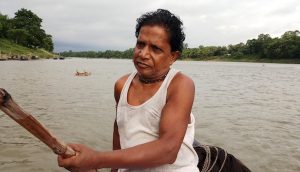
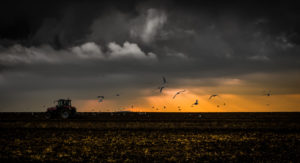

![The Indus at the site of the proposed Diamer-Basha dam [image by: Water and Power Development Authority, Pakistan]](https://dialogue.earth/content/uploads/2017/05/Indus_Diamer_Basha_Dam_Site_Image_WAPDA-300x169.jpg)
